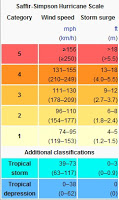The Saffir-Simpson Hurricane Scale
 Hopefully you took the time to watch the animation that Robin posted yesterday that illustrates the different hurricane intensities. But for those of you who don’t like what may be the super coolest graphic we’ve found yet, we’ll put the Saffir-Simpson Hurricane Scale in plain text.
Hopefully you took the time to watch the animation that Robin posted yesterday that illustrates the different hurricane intensities. But for those of you who don’t like what may be the super coolest graphic we’ve found yet, we’ll put the Saffir-Simpson Hurricane Scale in plain text.
According to Wikipedia, the scale was developed in 1971 by civil engineer Herbert Saffir and meteorologist Bob Simpson, who at the time was director of the U.S. National Hurricane Center (NHC). Mirroring the Richter magnitude scale in describing earthquakes, Saffir devised a 1–5 scale based on wind speed that showed expected damage to structures. Saffir gave the scale to the NHC, and Simpson added the effects of storm surge and flooding. The scale does not take into account rainfall or location, which means a Category 2 hurricane which hits a major city will likely do far more damage than a Category 5 hurricane that hits a rural area.
For math buffs, the scale is roughly logarithmic in wind speed, and the top wind speed for Category “c” (c=1, 2, 3, or 4) can be expressed as  miles per hour rounded to the nearest multiple of 5.
miles per hour rounded to the nearest multiple of 5.
Category 1
Category 1 storms usually cause no significant damage to building structures; however, they can tip over unanchored mobile homes, as well as uproot or snap trees. Poorly attached roof shingles or tiles can blow off. Also, they produce some coastal flooding, as well as minor pier damage.[8]
Recent example: Hurricane Boris (2008)
Category 2
Storms of this intensity damage some roofing material, and also produce damage to poorly constructed doors and windows. Considerable damage is caused to vegetation, poorly constructed signs, and piers. Mobile homes, whether anchored or not, are usually badly damaged, and many manufactured homes also suffer structural damage. Also, small craft in unprotected anchorages may break their moorings.
Recent example: Hurricane Dolly (2008)
Category 3
Tropical cyclones of this intensity and higher receive the name of major hurricanes when located in the Atlantic or Eastern Pacific basins. These storms can cause some structural damage to small residences and utility buildings, particularly those of wood frame or manufactured materials with minor curtainwall failures. Buildings that lack a solid foundation, such as mobile homes, are usually destroyed, and gable-end roofs are peeled off. Manufactured homes usually sustain very heavy and irreparable damage. Flooding near the coast destroys smaller structures, while larger structures are hit by floating debris. Additionally, terrain may be flooded well inland.
Recent example: Hurricane Lane (2006)
Category 4
Category 4 hurricanes tend to produce more extensive curtainwall failures, with some complete roof structural failure on small residences. Heavy, irreparable damage and near complete destruction of gas station canopies and other wide span overhang type structures are also common. Mobile and manufactured homes are leveled. These hurricanes cause major erosion of beach areas and terrain may be flooded well inland as well. Hurricanes of this intensity are extremely dangerous to populated areas.
Recent example: Hurricane Gustav (2008)
Category 5
Category 5 is the highest category a tropical cyclone can obtain in the Saffir-Simpson scale. These storms cause complete roof failure on many residences and industrial buildings, and some complete building failures with small utility buildings blown over or away. Collapse of many wide-span roofs and walls, especially those with no interior supports, is common. Very heavy and irreparable damage to many wood frame structures and total destruction to mobile/manufactured homes is prevalent. Only a few types of structures are capable of surviving intact, and only if located at least three to five miles inland.
The storm’s flooding causes major damage to the lower floors of all structures near the shoreline, and many coastal structures can be completely flattened or washed away by the storm surge. Storm surge damage can occur up to four city blocks inland, with flooding, depending on terrain, reaching six to seven blocks inland. Massive evacuation of residential areas may be required if the hurricane threatens populated areas. Storms of this intensity can be severely damaging.
Recent examples: Hurricanes Dean and Felix (2007)
Really, check out the animation. Hurricane intensity is more interesting to watch than read about.